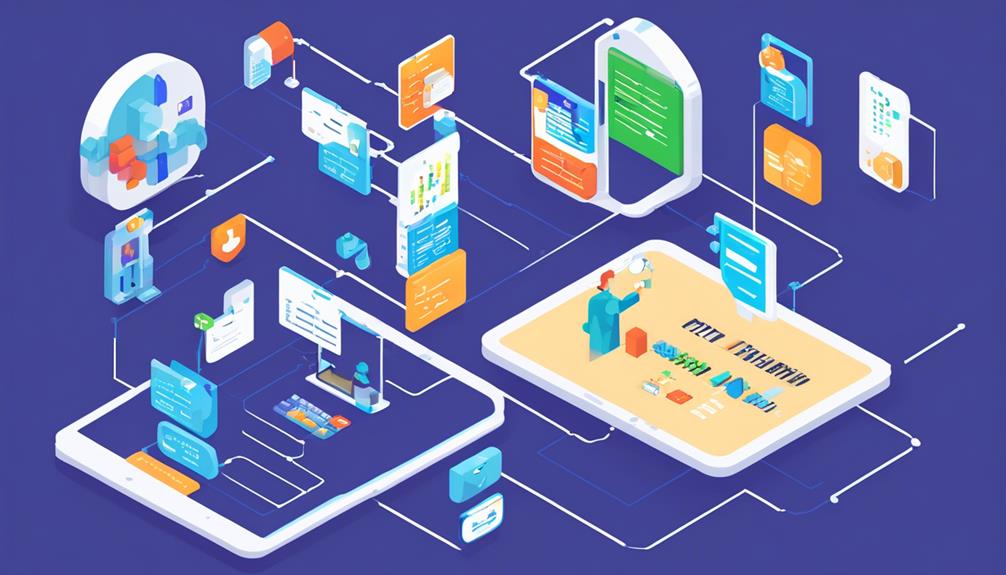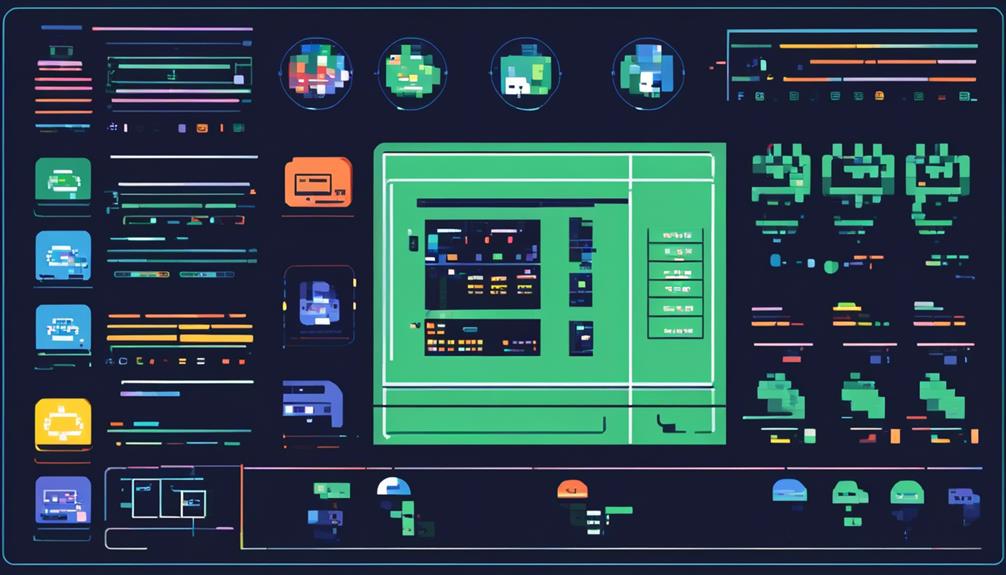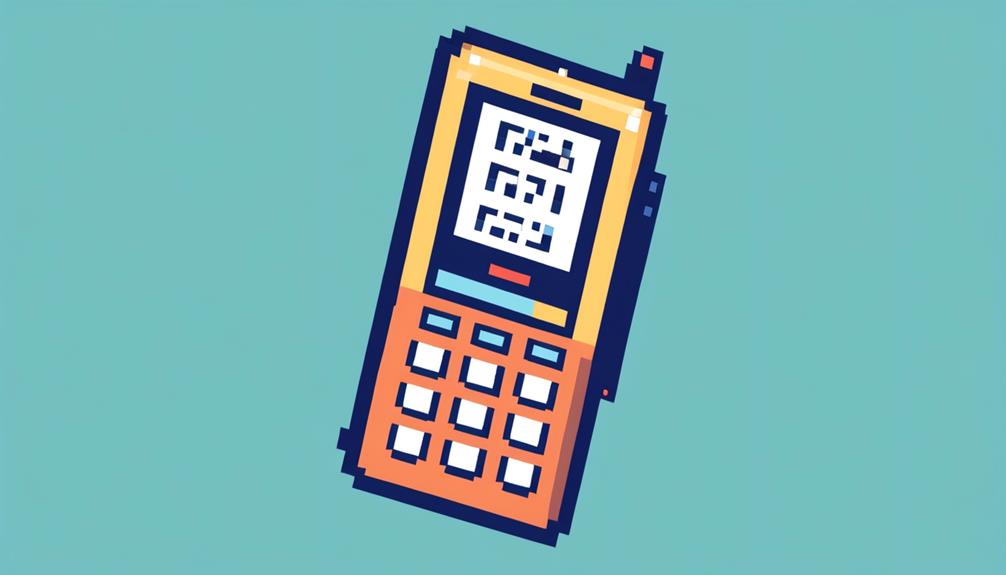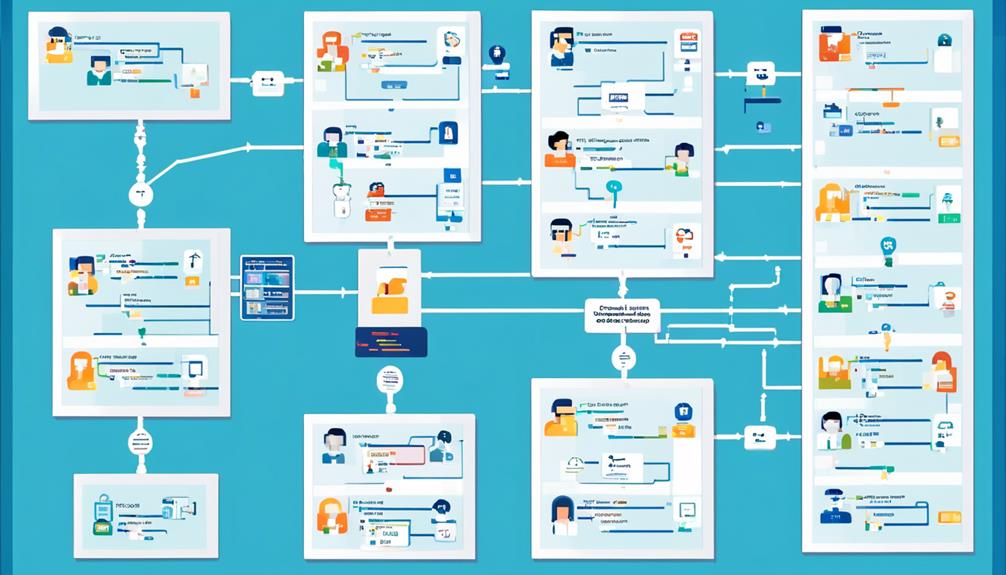Modern PBX systems offer a range of key features that are essential for businesses looking to enhance their communication infrastructure.
From online portal management to advanced call routing options, these systems provide a comprehensive solution for organizations of all sizes.
With virtual presence capabilities and auto-attendant features, businesses can establish a professional image and streamline their incoming calls.
Additionally, the integration with other software and number portability ensure seamless connectivity and flexibility.
The ability to record calls, set up custom voicemail greetings, and provide hold options further improve the overall user experience.
In this discussion, we will explore these key features in more detail, highlighting their importance and benefits for businesses in today's fast-paced and interconnected world.
Key Takeaways
- Modern PBX systems offer a range of management features including online portal management, virtual presence, auto-attendant, and integration with other software.
- Number portability and flexibility are important aspects of PBX systems, ensuring the ability to transfer existing phone numbers and eliminate downtime.
- Call recording and voicemail capabilities are essential for both compliance and training purposes, allowing for custom voicemail greetings and personalized experiences.
- The various call routing options provided by modern PBX systems, such as time-based routing, caller ID routing, and interactive voice response, ensure efficient call handling and enhanced customer experience.
Online Portal Management

How does online portal management enhance the functionality and control of modern PBX systems?
Online portal management is a crucial feature for businesses that rely on PBX phone systems. This tool allows users to access and adjust various PBX features, such as call transfer, call recording, voicemail transcription, call routing, and auto attendants, all from a convenient web-based platform.
One of the key advantages of online portal management is the ability to remotely access and customize PBX system settings. This feature offers businesses greater flexibility and convenience, allowing them to make adjustments from anywhere with an internet connection. Gone are the days of needing to be physically present in the office to modify phone system settings.
The online portal serves as a centralized interface for PBX system configuration, simplifying the management and optimization of the phone system. Businesses can easily monitor and control their PBX systems through this platform, ensuring efficient call handling and communication. Real-time adjustments are also possible, empowering businesses to adapt quickly to changing communication needs.
Moreover, the online portal's user-friendly interface makes it easy for businesses to navigate and utilize the various features of their PBX system. Users can quickly access and modify settings, saving time and streamlining the overall management process.
Virtual Presence
Virtual Presence is a key feature that allows businesses to establish a professional phone system appearance and access essential communication features, even without a physical office. With the advent of VoIP technology, PBX phone systems have evolved from traditional on-premises systems to IP PBX systems that leverage the internet to deliver advanced communication capabilities. Virtual Presence takes this a step further by allowing businesses to create a virtual office environment through cloud PBX systems or hosted PBX systems.
By utilizing virtual PBX technology, businesses can enable employees to work remotely while still maintaining a professional phone system appearance. Virtual Presence provides features such as call forwarding, voicemail, and auto-attendant, ensuring that customers and clients can reach the appropriate contact regardless of their physical location. This seamless communication experience is made possible through UCaaS (Unified Communications as a Service), which integrates various communication channels into a single platform.
Managing virtual presence is simple and convenient, with web-based portals or mobile applications providing users with the ability to access and configure their business phone system settings. This flexibility allows businesses to adapt to changing needs and scale their virtual presence as required.
Virtual Presence not only enhances communication capabilities but also offers cost savings and efficiency gains. By eliminating the need for a physical office, businesses can reduce overhead costs while still presenting a professional image. Additionally, virtual PBX systems offer scalability, allowing businesses to easily add or remove users as their needs evolve.
Auto-attendant

With the virtual presence established through cloud PBX systems or hosted PBX systems, businesses can enhance their communication capabilities by utilizing an automated system known as auto-attendant. This feature of modern PBX systems allows for efficient call handling and provides a professional image for the organization.
Here are some key features and benefits of auto-attendant:
- Call Routing: Auto-attendant directs callers to the appropriate extension or department based on their selection from a menu. This ensures that calls are efficiently routed to the right person or team, reducing the need for manual call transfers and improving overall customer experience.
- Personalized Greetings: Auto-attendant can be customized with personalized greetings and messages, allowing businesses to create a professional and branded image. These greetings can provide callers with important information about the organization and its services, enhancing customer engagement.
- Call Recording: Some modern PBX systems offer call recording capabilities, which can be integrated with the auto-attendant feature. This allows businesses to record important customer interactions for quality assurance, training purposes, or compliance requirements.
- Integration with UCaaS: Auto-attendant can be seamlessly integrated with Unified Communications as a Service (UCaaS) platforms, enabling businesses to leverage additional communication tools such as instant messaging, video conferencing, and presence information. This integration enhances collaboration and productivity within the organization.
- Ideal for Call Centers: Auto-attendant is particularly beneficial for call centers, where large volumes of calls need to be efficiently managed. It helps in reducing call wait times, improving call routing accuracy, and enhancing overall customer satisfaction.
Hold Options
Hold options in modern PBX systems provide callers with a range of features to enhance their waiting experience. The call waiting feature ensures that callers are put on hold with music or messaging, creating a professional and engaging atmosphere.
Additionally, the ability to customize hold music or messages based on departments or caller types allows for a more personalized experience.
Call Waiting Feature
The call waiting feature in modern PBX systems allows users to effectively manage multiple calls, ensuring they never miss important conversations. With this feature, users can put their current call on hold to answer an incoming call.
Here are the key benefits of the call waiting feature:
- Efficient call management: Users are notified of an incoming call while engaged in another conversation, allowing them to switch between calls seamlessly.
- Flexibility: Users have the option to choose whether to answer the incoming call or continue the current conversation uninterrupted.
- Reduced missed calls: The call waiting feature minimizes the chances of missing important calls, ensuring that businesses maintain excellent customer service.
- Enhanced user experience: By offering better call management options, this feature improves overall telephony experience for both businesses and individuals.
In modern PBX systems, the call waiting feature is just one of the many essential features that contribute to a robust and efficient phone system.
Music on Hold
Music on Hold is a valuable feature in modern PBX systems that enhances the caller experience by providing professional and engaging content while they wait for assistance. It allows businesses to play music or recorded messages to callers on hold, keeping them entertained and informed.
This feature can be customized to reflect the brand and convey important information about products, services, or promotions. By contributing to a positive customer experience and reducing the perception of wait times, Music on Hold leads to higher satisfaction levels.
Advanced PBX systems offer dynamic options for Music on Hold, enabling businesses to tailor the content based on caller demographics, preferences, or specific marketing campaigns. Whether it is a legacy or IP-based, traditional or cloud-based PBX system, Music on Hold is a must-have feature that enhances the overall caller experience.
Integration With Other Software

Integration with other software is a crucial feature of modern PBX systems, enabling businesses to streamline processes and enhance productivity. By integrating with various software applications such as CRM systems, PBX systems can provide a unified platform for data management and improved customer interactions.
Here are the key benefits of integration with other software in PBX systems:
- Streamlined Workflows: Integration allows PBX systems to combine communication tools with other essential applications, creating a seamless workflow. Users can access and manage communication data within the same interface as their other business software, eliminating the need for switching between different platforms.
- Advanced Features: Integration with other software enables PBX systems to provide advanced features such as call logging, reporting, and analytics. These features allow businesses to gain insights into their communication patterns, optimize their customer service, and make data-driven decisions.
- Collaboration: PBX systems can integrate with collaboration tools, enabling employees to communicate seamlessly across different platforms. This integration enhances teamwork and productivity by providing a unified communication experience.
- Enhanced Customer Service: Integration with software applications allows businesses to deliver enhanced customer service. By integrating PBX systems with CRM systems, for example, customer data can be easily accessed during calls, enabling personalized interactions and better customer satisfaction.
- Increased Efficiency: Integration with other software streamlines processes and reduces the time spent on manual tasks. This efficiency improvement allows businesses to focus on core activities, leading to increased productivity.
- Future-Proofing: As legacy PBX systems are gradually being replaced by IP-based PBX systems, integration capabilities ensure compatibility with modern technologies and future-proofing of the phone system.
Scalability and Expansion Capabilities
Scalability and expansion capabilities are crucial considerations when evaluating modern PBX systems. These systems offer businesses the ability to easily accommodate growth and add new users and features without the need for extensive infrastructure changes.
With the flexibility to scale up or add satellite offices, PBX systems provide organizations with the agility to adapt to changing needs and seize new opportunities.
Growth Potential
Modern PBX systems offer significant growth potential through their scalability and expansion capabilities. These systems allow organizations to seamlessly accommodate increasing user and phone line demands as their business expands.
This growth potential is made possible by leveraging technologies such as VoIP, Session Initiation Protocol (SIP) trunking, and cloud phone systems. By integrating these technologies, PBX systems can easily adapt to the evolving communication needs of businesses.
Furthermore, modern PBX systems can be integrated with other digital PBX systems and UCaaS platforms. This integration provides organizations with a wide range of advanced features and functionalities. It ensures that businesses can scale their communication infrastructure without major disruptions and stay ahead in today's competitive landscape.
Flexibility for Expansion
The flexibility for expansion in modern PBX systems allows organizations to seamlessly accommodate increasing user and phone line demands as their business expands. Scalability is a key feature that enables the PBX system to grow and adapt to changing needs.
With expansion capabilities, organizations can easily integrate new technologies and communication tools into their PBX system. This flexibility ensures that the system can handle increased call volume and additional communication requirements.
Whether it is a large or small business, modern PBX systems offer the ability to scale up or down as needed. This flexibility also extends to the choice of deployment options, with hosted PBX services eliminating the need for upfront equipment costs and ongoing maintenance fees.
The expansion capabilities of modern PBX systems provide organizations with the agility and scalability needed to support their growth and evolving communication needs.
Call Analytics and Real-Time Data Insights

Call Analytics and Real-Time Data Insights provide organizations with detailed information on call metrics and patterns, empowering them to make data-driven decisions for optimizing their phone system performance. These features are essential in modern PBX systems as they enable businesses to gain valuable insights into their communication processes and make informed decisions to improve efficiency and customer satisfaction.
Here are the key benefits of incorporating Call Analytics and Real-Time Data Insights into a PBX system:
- Enhanced Call Monitoring: With real-time data insights, businesses can monitor call volume, call duration, and peak call times. This information allows them to assess call traffic patterns and allocate resources accordingly, ensuring that customers are not kept waiting and calls are handled efficiently.
- Trend Identification: Call Analytics help businesses identify trends in customer preferences and behavior. By analyzing call data, organizations can gain valuable insights into customer needs, enabling them to tailor their services and improve customer satisfaction.
- Performance Optimization: Real-time data insights enable businesses to make immediate adjustments to call handling. For example, if call volumes are high during a particular time of day, businesses can allocate more staff to handle calls during that period, reducing wait times and improving customer experience.
- Continuous Improvement: By analyzing call metrics and patterns, organizations can identify areas for improvement in communication processes. This could involve training staff, implementing new call handling techniques, or optimizing phone line configurations to streamline communication.
- Data-Driven Decision Making: Call Analytics and Real-Time Data Insights provide businesses with objective data that can guide decision-making processes. By using data to inform their choices, organizations can make more accurate predictions, improve operational efficiency, and ultimately enhance overall business performance.
Incorporating Call Analytics and Real-Time Data Insights into modern PBX systems is crucial for businesses looking to optimize their phone system performance. These features provide valuable information and actionable insights that enable organizations to make data-driven decisions, improve customer satisfaction, and drive business growth.
Desktop and Mobile App Availability
Desktop and mobile app availability enhances the functionality and accessibility of PBX systems, allowing users to seamlessly utilize key features and functions across multiple devices. With the rise of VoIP technology, PBX systems have transitioned from traditional analog systems to IP-based systems. This shift has enabled businesses to leverage their existing IP networks and internet connections to make and receive calls, reducing costs associated with the use of the Public Switched Telephone Network (PSTN).
By integrating desktop and mobile apps into the PBX system, users can access their phone service from their preferred devices, including computers and smartphones. These apps provide users with the ability to make and receive calls, access voicemail, and manage call settings, all from a single interface. Whether in the office, at home, or on the go, users can stay connected and productive.
To utilize the desktop and mobile apps, users need to have an active internet connection and a service provider that supports the PBX system. The apps are typically provided by the PBX vendor and can be installed on various operating systems, including Windows, macOS, iOS, and Android. Once installed, users can log in using their credentials and access their PBX features and functions.
The availability of desktop and mobile apps not only enhances the flexibility and convenience for users but also facilitates seamless communication and collaboration within the organization. Users can easily transfer calls, access call logs, and utilize other PBX features, regardless of their location or device. This integration of PBX systems with desktop and mobile apps is a key feature of modern PBX systems, enabling businesses to adapt to the changing communication landscape and improve productivity.
Number Portability

Number portability is a crucial feature in modern PBX systems that offers seamless number transfer. This provides businesses with the flexibility to change service providers without disrupting their existing phone numbers.
This eliminates downtime and ensures uninterrupted communication with clients and partners. By enabling the retention of phone numbers, number portability enhances customer convenience and satisfaction.
Seamless Number Transfer
Seamless Number Transfer, a crucial feature of modern PBX systems, enables organizations to effortlessly retain their existing phone numbers when transitioning to a new system. This capability eliminates the need for organizations to change their contact information, minimizing disruption for customers and clients.
Here are two key benefits of seamless number transfer:
- Business Continuity: Number portability ensures the continuity of business operations by allowing organizations to maintain their existing phone numbers. This avoids the need for customers and clients to update their contact information, reducing the risk of losing communication and maintaining brand identity.
- Smooth Transition: Seamless number transfer simplifies the transition to a modern PBX system. It involves transferring phone numbers from the current provider to the new PBX system without affecting service quality. This feature supports customer retention efforts, making the migration process seamless and hassle-free.
Flexibility in Phone Numbers
To maintain business operations and established phone numbers, organizations can leverage the flexibility of number portability when adopting a new PBX system or service provider.
Number portability is a key feature of modern PBX systems that allows businesses to keep their existing phone numbers when transitioning to a new system or provider. This feature ensures seamless continuity of business operations without the need to change contact information.
By retaining familiar and recognizable phone numbers, businesses can maintain customer recognition and trust even during the transition. Additionally, number portability eliminates the hassle of updating marketing materials and other collateral with new phone numbers, saving valuable time and resources.
This flexibility in phone numbers is particularly beneficial for businesses looking to switch to a more suitable or cost-effective PBX system or service provider, without losing their established phone numbers.
Elimination of Downtime
During the transition process, businesses can ensure uninterrupted communication and avoid disruptions by utilizing the feature of number portability in modern PBX systems.
This feature allows businesses to retain their existing phone numbers when switching to a new PBX system or provider, eliminating potential downtime and customer communication disruption.
The elimination of downtime through number portability enables continuity of service and maintains business professionalism by keeping established phone numbers.
Additionally, number portability simplifies the migration process and minimizes the impact on daily operations, ensuring a smooth and seamless transition.
With this feature, businesses can confidently switch to modern PBX systems without the fear of losing their phone numbers or experiencing any communication interruptions.
Call Recording

Call recording is a crucial feature in modern PBX systems, allowing businesses to capture and store telephone conversations for various purposes. It provides a means to review and assess customer interactions, ensuring compliance and enhancing service delivery. By recording incoming and outgoing calls, businesses can maintain accurate records of conversations, which can be used for dispute resolution, training, and quality assurance.
Modern PBX systems often offer call recording as a standard feature, ensuring comprehensive communication management. This feature is particularly valuable for businesses that rely on VoIP (Voice over Internet Protocol) technology, as it allows for the recording of calls made over the internet. Call recording can be implemented across multiple trunks, enabling businesses to capture and store a large volume of conversations.
To engage the audience, let's present the benefits of call recording in a table format:
| Benefit | Description |
|---|---|
| Compliance | Call recording helps businesses adhere to industry regulations and compliance standards. |
| Training | Recorded calls serve as valuable training resources for new employees, allowing for skill improvement. |
| Dispute resolution | Having a record of conversations can help resolve disputes and provide evidence if needed. |
| Service enhancement | By reviewing recorded calls, businesses can identify areas for improvement and enhance customer service. |
Incorporating call recording into modern PBX systems ensures that businesses maintain compliance, improve customer service, and train staff effectively. It is a valuable tool for capturing and storing telephone conversations, providing businesses with a comprehensive communication management solution.
Custom Voicemail Greetings
With call recording serving as a valuable feature in modern PBX systems, the next aspect to explore is the importance of custom voicemail greetings in enhancing customer service and presenting a professional image for businesses.
Custom voicemail greetings allow users to personalize their voicemail message for callers, providing a unique and branded experience. Here are some key reasons why custom voicemail greetings are essential in modern business phone systems:
- Personalization: Custom voicemail greetings enable users to record a unique message that can convey important details to callers. This can include business hours, alternative contact methods, or any other relevant information. By customizing the voicemail greeting, businesses can provide a personalized touch to their communication with customers.
- Professionalism: Custom voicemail greetings offer a professional touch by presenting a tailored message to callers when they are unable to answer the phone. This creates a positive impression of the organization and enhances the overall customer experience. A well-crafted and professional voicemail greeting can instill confidence in callers and leave a lasting positive impression.
In the era of VoIP (Voice over Internet Protocol) and modern PBX systems, custom voicemail greetings have become an essential feature. Unlike traditional phone systems that relied on physical phone lines and limited voicemail capabilities, VoIP telephony allows for more flexibility and customization. Digital phone signals can be easily managed through a PBX box, enabling businesses to create and update custom voicemail greetings effortlessly.
Call Routing Options

Efficiently managing incoming calls is crucial for businesses, and one key aspect of achieving this is through effective call routing options. Modern PBX systems offer a range of call routing features that allow businesses to direct incoming calls to specific extensions or departments based on various criteria. These features can greatly enhance the customer experience and improve overall call handling efficiency.
Here is a table highlighting some of the key call routing options available in modern PBX systems:
| Call Routing Option | Description |
|---|---|
| Time-based Routing | Calls can be routed differently based on the time of day or day of the week. This ensures that calls are directed to the appropriate department or voicemail during specific hours. |
| Caller ID Routing | Calls can be routed based on the caller's ID, allowing businesses to prioritize calls from important clients or VIP customers. |
| Interactive Voice Response (IVR) | IVR menus allow callers to make selections using their keypad, which can route them to the desired department or provide them with relevant information. |
| Simultaneous Ringing | This option allows multiple extensions to ring simultaneously, ensuring that incoming calls are answered promptly by the first available employee. |
| Sequential Ringing | With sequential ringing, incoming calls are directed to a series of extensions in a predetermined order. This ensures that calls are answered if the primary extension is busy or unavailable. |
These call routing options can be configured and managed through the PBX system's control unit or software interface. They provide small businesses with the flexibility to customize their call handling processes and enhance their communication capabilities.
Modern PBX systems, especially those based on IP or VoIP technology, also offer seamless integration between inbound and outbound calls, allowing businesses to efficiently manage external phone lines. This integration ensures a smooth flow of communication and enables businesses to handle customer calls effectively.
Frequently Asked Questions
What Are the Features of PBX System?
PBX systems offer a range of features that enhance communication within an organization. These features include:
- Cloud-based solutions
- Virtual PBX systems
- Advanced call routing
- Interactive Voice Response (IVR)
- Call analytics and reporting
- Unified communications integration
- Mobile device integration
- Call recording and monitoring
- Scalability and flexibility in system configuration
These features enable businesses to streamline their communication processes, improve customer service, and enhance overall efficiency.
What Are the Three Main Components of the Pbx?
The three main components of a PBX system are telephones, cables, and a control unit. The control unit plays a crucial role in managing call routing and features within the PBX system.
Additionally, PBX systems require software for configuration and management. Modern PBX systems often utilize VoIP technology for communication. Other components, such as call recording and voicemail systems, can be added for enhanced functionality.
It is important to consider these hardware requirements when choosing the right PBX provider for your business.
What Is the Basic of PBX Technology?
PBX technology has evolved significantly over the years, offering numerous advantages for businesses. It improves communication efficiency by allowing internal lines to connect with external phone lines, enabling simultaneous handling of multiple calls.
Modern PBX systems incorporate key elements such as VoIP technology, call recording, and voicemail systems. These features enhance communication capabilities and streamline business operations.
PBX systems play a crucial role in modern business environments, providing cost savings, scalability, and centralized management. They allow businesses to reduce costs by consolidating multiple phone lines into a single system. Additionally, PBX systems can easily scale to accommodate the growing needs of a business, making them a flexible and future-proof solution.
Furthermore, PBX systems can integrate with other communication tools such as email, instant messaging, and video conferencing. This integration enhances collaboration among employees and improves overall productivity. Moreover, PBX systems can have a positive impact on customer service by enabling advanced call routing and providing features like call queuing and automated greetings.
Looking into the future, PBX technology is expected to continue advancing. Further advancements in features such as artificial intelligence and speech recognition are likely to be integrated into PBX systems, enhancing their capabilities. Additionally, increased integration capabilities with other business tools and cloud-based services are anticipated, providing even more flexibility and convenience for businesses.
What Are PBX PSTN Service and Features?
PBX PSTN service refers to the integration of PBX technology with the Public Switched Telephone Network (PSTN). By utilizing PBX systems, organizations can benefit from improved communication efficiency, cost savings, and enhanced customer service.
Key considerations when choosing a PBX provider include reliability, scalability, and integration options with other business tools such as CRM systems.
Implementing a PBX system may present challenges, but advancements in PBX technology continue to shape the future of communication systems.

